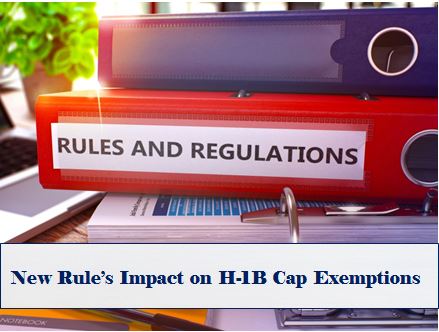 The H-1B visa is highly sought-after. For several years now, the annual cap of 85,000 has been reach within days of the start of the filing season every April.
The H-1B visa is highly sought-after. For several years now, the annual cap of 85,000 has been reach within days of the start of the filing season every April.
One way to help employers apply to obtain a cap-exempt H-1B visa is to help them determine if they can be considered a cap-exempt organization or whether a foreign national could qualify to work concurrently for both cap-subject and cap-exempt organizations.
The new High-Skilled Workers rule has made some notable changes to the H-1B cap exemption requirements. Some of them are beneficial, while others are more limiting. Here is what you need to know about the new regulations.
How does the new rule impact H-1B cap exemptions?
There are two major changes to eligibility for an exemption from the H-1B cap.
- Previously, only federal government research organizations could qualify for the cap exemption. Now state and local government research organizations are also eligible.
- There is an additional way to qualify as a related or affiliated non-profit entity with an institution of higher education or governmental research organizations. Previously, USCIS required an affiliation to be shown through evidence of shared ownership or control by the same board or federation, or that the nonprofit is attached to the university as a member, branch, cooperative, or subsidiary.
The new rule expands the definition of related or affiliated to include that the nonprofit entity can have entered into a formal written affiliation agreement with an institution of higher education that establishes both an active working relationship between the nonprofit entity and the institution of higher education for the purposes of research or education, and that one of the primary purposes of the nonprofit entity’s relationship is to directly contribute to the research or education mission of the institution of higher education.
For example, if a non-profit enters into a written agreement to house university students as interns, this non-profit can seek H-1B cap exemption status based on its affiliation with the university as long as a “fundamental activity” of the nonprofit directly contributes to the research or education mission of university.
If my nonprofit organization previously qualified for a H-1B cap exemption based on its relation to or affiliation with an institution of higher education, will it still qualify under the new rule?
Your organization may still qualify, but it is no longer guaranteed.
Previously, USCIS generally deferred to the prior agency determination that a nonprofit entity is cap-exempt based on its relation to or affiliation with an institution of higher education. This new rule did not carry forward that deference policy. Now they will need to adjudicate the case to determine if your nonprofit organization will qualify.
How does the new rule impact concurrent employment for a cap-exempt and cap-subject employer?
Under the new rule, you are only approved for the validity period of the cap-exempt petition. Once your employment ends with the cap-exempt employer, you must stop work for the cap-subject employer. Also, the validity of cap-subject employment cannot be for a date before or after the cap-exempt petition.